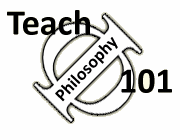Teach Philosophy 101
Free resources for
philosophy teachers!
"One of the most comprehensive, well-researched, and accessible guides for teachers that I have ever seen." James Lang, Chronicle of Higher Education (read full review of TΦ101)
Team-Based Learning
Team-Based Learning (TBL) is a pedagogical technique developed by Larry Michaelsen, which emphasizes small-group collaboration over an entire semester, structures class periods around student peer- and self-assessment and the application of knowledge to new problems.
How does it work?
For a broad overview of the technique, see the National Education Association website and the article, "Team-Based Learning" by Michaelsen and Sweet (2011) in New Directions in Teaching and Learning. Although some of this material is directed toward secondary education rather than college, it can be adapted to work in the college philosophy classroom.
The Four Basic Elements of TBL
These four elements can each be useful on their own, even if you do not adopt the semester-long TBL strategy. Here is a quick overview, based on Michaelsen, Sweet, and Parmalee (2009).
-
Groups: Student groups in TBL are formed by the instructor, with an eye to avoiding cliques and making them as diverse as possible. Because students will be learning from one another, it is important to understand "diversity" here not only in terms of demographics, but also in terms of relevant strengths, academic background, etc.
-
Accountability: Students are accountable for their performance both as individuals and as groups. In the TBL system, this is accomplished by 1) having students take a quick, individual quiz as soon as they enter the class, and then 2) taking a group quiz on the same material. Both scores count toward their grade (though you may adjust the relative weights as needed). The idea is that students will correct one another, argue about the correct answer, and ultimately, teach one another. This also provides them motivation to come to class prepared.
-
Feedback: Students receive frequent and (very!) timely feedback in the TBL system. This is often accomplished via scratch-off cards called the "Instant Feedback Assessment Technique" (IF-AT), which allows students to see, immediately, whether they have come to the correct answer or not. On the TBL model, the IF-AT cards are used for the group quiz stage. The quiz itself is set up in a multiple-choice format. If students choose and scratch off the correct answer, they reveal a star underneath; if their answer is incorrect, there will simply be a blank space. The TBL technique calls for students to be given partial credit for answers arrived at after the first guess (i.e., 5 points for getting the correct answer on the first try, 3 points for the second try, 1 point for the third, 0 points for the fourth). This motivates students to keep working on a problem if they get it wrong at first. I have used this technique with great success in a variety of classes. The cards are available for purchase from Epstein Educational Enterprises.
-
Assignment Design: To be effective, TBL has to be structured around assignments that both promote team cohesion and enable teams to report their conclusions simply. This means that while the assignment has to be about getting students to make decisions about a complex problem, the "output" itself cannot be complex--in other words, TBL as a technique does not work particularly well if your goal is to get students to co-write an essay. The reason for this is that if students are focusing on the various elements of the "output," they tend to spend less time working collaboratively, and more time splitting the work up. For this reason, TBL is particularly effective where answers can be reported using multiple-choice format (it is particularly useful in Logic, for example).
Where can TBL go?
Team-Based Learning has become popular recently in both medical and business schools, and is making inroads in foreign language classrooms in higher education--my colleague, Henry Bayerle, recently published a piece about using TBL to teach Greek.
More of interest to readers of TP101, Kimberly Van Ormen (Bennington College) has published a piece on using TBL to teach Philosophy. As Van Ormen puts it,
Team-Based Learning is a comprehensive approach to using groups purposefully and effectively. Because of its focus on decision making, it is well suited to helping students learn to do philosophy and not simply talk about it. (2015, emphasis mine)
Sources:
Bayerle, Henry. 2013. "Team-Based Learning to Promote the Study of Greek," Teaching Classical Languages 5:1.
Michaelsen, Larry and Michael Sweet. 2011. "Team-Based Learning," New Directions in Teaching and Learning . Vol. 128. 41-51.
Van Ormen, Kimberly. 2015. "Teaching Philosophy with Team-Based Learning," American Association of Philosophy Teachers Studies in Pedagogy.
See also this overview based on Michaelsen, Sweet, and Parmalee, 2009, "Team-Based Learning: Small Group Learning's Next Big Step," New Directions in Teaching and Learning.
Author: Erin Tarver (updated June 2017)
